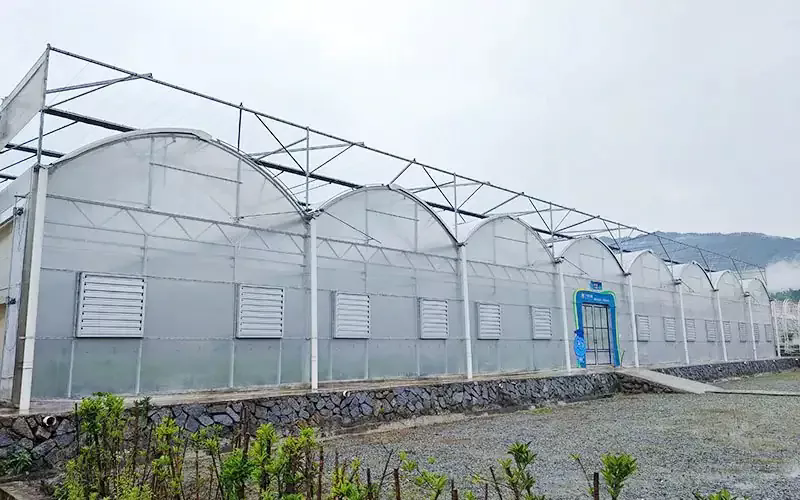Why Should You Consider a Plastic Greenhouse for Your Gardening Needs?
2024-12-07
As gardening continues to grow in popularity, many enthusiasts and professional growers are seeking ways to extend their growing season, protect their plants, and optimize their space. One solution that has become increasingly popular is the plastic greenhouse. But why should you consider a plastic greenhouse for your gardening needs? In this blog, we’ll explore the advantages of using a plastic greenhouse, the different types available, and how it can transform your gardening experience.
What Is a Plastic Greenhouse?
A plastic greenhouse is a structure designed to protect plants from external weather conditions by creating a controlled environment. Unlike traditional glass greenhouses, which can be heavy and expensive, plastic greenhouses use various types of plastic materials—such as polyethylene, polycarbonate, or polyvinyl chloride (PVC)—to cover the structure. These materials offer excellent insulation properties, protect plants from pests, and allow for better light diffusion, all while being lightweight and cost-effective.
Types of Plastic Greenhouses
Plastic greenhouses come in several different forms, with varying levels of durability, insulation, and light diffusion. Here are the main types of plastic materials used for greenhouse coverings:
1. Polyethylene (PE): This is the most commonly used plastic for greenhouse covers. Polyethylene is lightweight, cost-effective, and provides excellent UV protection. It’s often used in single or double layers for better insulation.
2. Polycarbonate (PC): Polycarbonate is a more durable and insulated material compared to polyethylene. It’s often used for more permanent greenhouses and provides better protection against extreme weather conditions. It also has a higher degree of light diffusion, which promotes better plant growth.
3. Polyvinyl Chloride (PVC): PVC is often used in smaller, portable greenhouses. It’s durable, weather-resistant, and provides good light transmission, but it’s typically not as insulative as polycarbonate or polyethylene.
4. Inflatable Plastic Greenhouses: A more innovative approach, inflatable greenhouses use double layers of plastic that are inflated to create an insulating effect. These are more commonly used for temporary or mobile greenhouses.
Each type has its own set of benefits, depending on the growing conditions, climate, and the type of plants you wish to grow.
Why Choose a Plastic Greenhouse?
1. Cost-Effective Solution
One of the biggest advantages of plastic greenhouses is their cost-effectiveness. Compared to traditional glass greenhouses, plastic greenhouses are significantly less expensive to build, maintain, and repair. The lightweight nature of plastic materials makes them easier to transport and install, cutting down on both labor and material costs.
2. Improved Insulation and Temperature Control
Plastic greenhouses, especially those with double layers or polycarbonate panels, provide excellent insulation. This helps to maintain a stable temperature inside the greenhouse, which is especially important for growing plants that require specific temperature ranges. The insulation prevents heat from escaping during cold nights while reducing excessive heat buildup on hot days. As a result, plants thrive in an environment that is protected from the extremes of the outside weather.
3. UV Protection and Light Diffusion
Plastic greenhouses offer superior protection against harmful UV rays. Materials like polyethylene and polycarbonate can block or filter harmful UV radiation, protecting your plants from sunburn or damage. Additionally, plastic provides better light diffusion than glass, ensuring that plants receive an even distribution of light, which is essential for healthy growth. This helps reduce shadows and encourages plants to grow evenly, making the most of available light.
4. Durability and Flexibility
Plastic greenhouses are incredibly durable, especially when made from UV-resistant polyethylene or polycarbonate. These materials are designed to withstand harsh weather conditions such as high winds, rain, and even snow. Unlike glass, which can shatter or crack, plastic is more resilient to impact and is less likely to break under pressure.
Additionally, plastic greenhouses come in a wide range of sizes and designs, from small, portable structures to large, permanent setups. This flexibility makes it easy for gardeners to choose a greenhouse that fits their specific needs, whether it's for personal use or for commercial growing.
5. Pest and Weather Protection
A plastic greenhouse offers protection against pests and insects that can harm your plants. By creating a barrier between your plants and the outside environment, a greenhouse keeps unwanted pests away, reducing the need for chemical pesticides. It also protects plants from weather-related damage, such as heavy rain, strong winds, or hail, which can be especially important in regions with unpredictable climates.
6. Extended Growing Season
Perhaps one of the most significant benefits of using a plastic greenhouse is the ability to extend your growing season. In colder climates, a greenhouse can provide a warm and protected environment during the colder months, allowing you to start planting earlier in the spring and continue growing well into the fall or winter. This is particularly beneficial for gardeners who wish to grow crops that are sensitive to frost, such as tomatoes, peppers, or herbs.
What Are the Maintenance Considerations for Plastic Greenhouses?
While plastic greenhouses require less maintenance than glass greenhouses, they still need some care to keep them in optimal condition:
- Cleaning: Over time, dust, dirt, and plant debris can accumulate on the plastic, reducing light transmission. Regular cleaning with a gentle soap solution and water will help maintain clear plastic surfaces.
- UV Degradation: While plastic materials are designed to resist UV radiation, they can degrade over time due to prolonged exposure. It’s important to check for any signs of wear and replace sections of plastic if necessary.
- Structural Integrity: Ensure the frame of the greenhouse is stable and secure, especially in areas prone to high winds or heavy snow. Regularly inspect the frame for any signs of rust or damage.
How to Choose the Right Plastic Greenhouse?
When choosing a plastic greenhouse, consider the following factors:
- Climate: If you live in an area with harsh winters or high temperatures, opt for materials with better insulation properties, such as polycarbonate.
- Size and Space: Think about the available space in your garden or backyard and choose a greenhouse that fits comfortably in your area. There are many sizes and shapes available, from compact hobby greenhouses to larger commercial units.
- Budget: Your budget will play a big role in the type of greenhouse you choose. Polycarbonate greenhouses tend to be more expensive but offer superior durability and insulation, while polyethylene options are more affordable but may require more frequent replacements.
Conclusion: Is a Plastic Greenhouse Right for You?
A plastic greenhouse can be a game-changer for gardeners looking to protect their plants, extend their growing season, and create an ideal growing environment. With their cost-effectiveness, durability, and versatility, plastic greenhouses offer numerous benefits that can enhance your gardening experience. Whether you're a hobbyist gardener or a commercial grower, a plastic greenhouse could be the perfect investment to boost your plant production and ensure healthy, thriving crops year-round.



